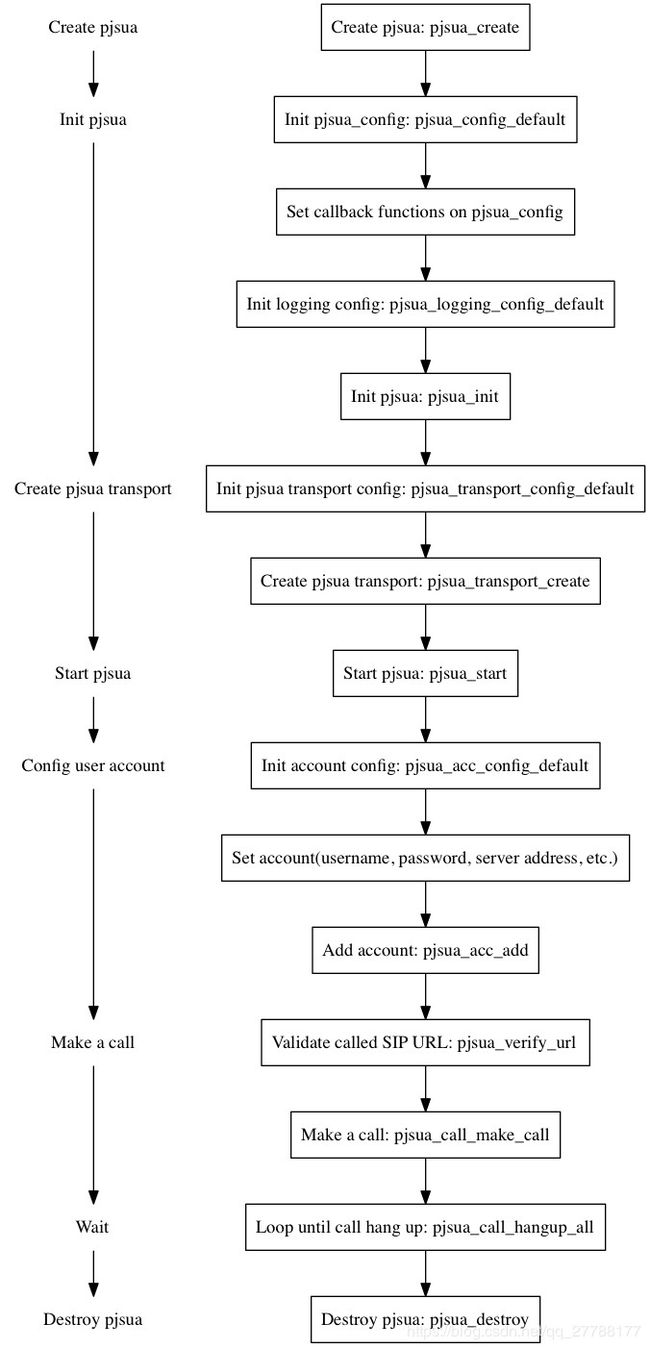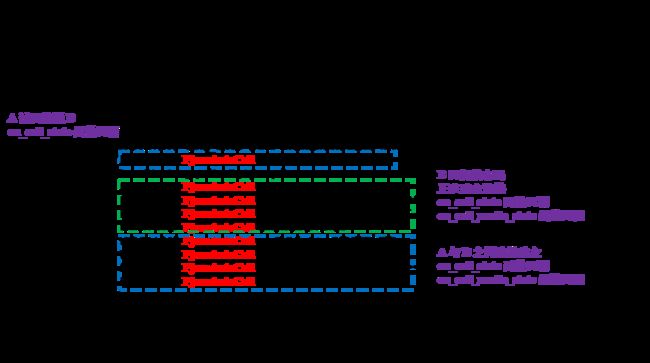【网络通信 -- SIP 电话】PJSUA API 学习与客户端开发 -- 实现简单的通话功能
【网络通信 -- SIP 电话】PJSUA API 学习与客户端开发 -- 实现简单的通话功能
【1】基于 PJSUA 库的 Linux C 开发环境搭建与 Makefile 编写
#Modify this to point to the PJSIP location.
# PJBASE 指定 pjproject 的源代码路径
PJBASE=/home/myself/pjproject-0.5.10.2
include $(PJBASE)/build.mak
CC = $(PJ_CC)
LDFLAGS = $(PJ_LDFLAGS)
LDLIBS = $(PJ_LDLIBS)
CFLAGS = $(PJ_CFLAGS)
CPPFLAGS= ${CFLAGS}
# If your application is in a file named myapp.cpp or myapp.c
# this is the line you will need to build the binary.
# 假定用于编写的 SIPSUA API 测试代码为 myapp.cpp
all: myapp
myapp: myapp.cpp
$(CC) -o $@ $< $(CPPFLAGS) $(LDFLAGS) $(LDLIBS)
clean:
rm -f myapp.o myapp【2】基于 PJSUA API 实现的简单通话功能代码示例
PJSIP 官方提供的示例代码如下,该示例程序展示了使用 PJSUA API 编写客户端实现一次通话的全过程。
/* $Id: simple_pjsua.c 3553 2011-05-05 06:14:19Z nanang $ */
/*
* Copyright (C) 2008-2011 Teluu Inc. (http://www.teluu.com)
* Copyright (C) 2003-2008 Benny Prijono
*
* This program is free software; you can redistribute it and/or modify
* it under the terms of the GNU General Public License as published by
* the Free Software Foundation; either version 2 of the License, or
* (at your option) any later version.
*
* This program is distributed in the hope that it will be useful,
* but WITHOUT ANY WARRANTY; without even the implied warranty of
* MERCHANTABILITY or FITNESS FOR A PARTICULAR PURPOSE. See the
* GNU General Public License for more details.
*
* You should have received a copy of the GNU General Public License
* along with this program; if not, write to the Free Software
* Foundation, Inc., 59 Temple Place, Suite 330, Boston, MA 02111-1307 USA
*/
/**
* simple_pjsua.c
*
* This is a very simple but fully featured SIP user agent, with the
* following capabilities:
* - SIP registration
* - Making and receiving call
* - Audio/media to sound device.
*
* Usage:
* - To make outgoing call, start simple_pjsua with the URL of remote
* destination to contact.
* E.g.:
* simpleua sip:user@remote
*
* - Incoming calls will automatically be answered with 200.
*
* This program will quit once it has completed a single call.
*/
#include
#define THIS_FILE "APP"
#define SIP_DOMAIN "example.com"
#define SIP_USER "alice"
#define SIP_PASSWD "secret"
/* Callback called by the library upon receiving incoming call */
static void on_incoming_call(pjsua_acc_id acc_id, pjsua_call_id call_id,
pjsip_rx_data *rdata)
{
pjsua_call_info ci;
PJ_UNUSED_ARG(acc_id);
PJ_UNUSED_ARG(rdata);
pjsua_call_get_info(call_id, &ci);
PJ_LOG(3,(THIS_FILE, "Incoming call from %.*s!!",
(int)ci.remote_info.slen,
ci.remote_info.ptr));
/* Automatically answer incoming calls with 200/OK */
pjsua_call_answer(call_id, 200, NULL, NULL);
}
/* Callback called by the library when call's state has changed */
static void on_call_state(pjsua_call_id call_id, pjsip_event *e)
{
pjsua_call_info ci;
PJ_UNUSED_ARG(e);
pjsua_call_get_info(call_id, &ci);
PJ_LOG(3,(THIS_FILE, "Call %d state=%.*s", call_id,
(int)ci.state_text.slen,
ci.state_text.ptr));
}
/* Callback called by the library when call's media state has changed */
static void on_call_media_state(pjsua_call_id call_id)
{
pjsua_call_info ci;
pjsua_call_get_info(call_id, &ci);
if (ci.media_status == PJSUA_CALL_MEDIA_ACTIVE) {
// When media is active, connect call to sound device.
pjsua_conf_connect(ci.conf_slot, 0);
pjsua_conf_connect(0, ci.conf_slot);
}
}
/* Display error and exit application */
static void error_exit(const char *title, pj_status_t status)
{
pjsua_perror(THIS_FILE, title, status);
pjsua_destroy();
exit(1);
}
/*
* main()
*
* argv[1] may contain URL to call.
*/
int main(int argc, char *argv[])
{
pjsua_acc_id acc_id;
pj_status_t status;
/* Create pjsua first! */
status = pjsua_create();
if (status != PJ_SUCCESS) error_exit("Error in pjsua_create()", status);
/* If argument is specified, it's got to be a valid SIP URL */
if (argc > 1) {
status = pjsua_verify_url(argv[1]);
if (status != PJ_SUCCESS) error_exit("Invalid URL in argv", status);
}
/* Init pjsua */
{
pjsua_config cfg;
pjsua_logging_config log_cfg;
pjsua_config_default(&cfg);
cfg.cb.on_incoming_call = &on_incoming_call;
cfg.cb.on_call_media_state = &on_call_media_state;
cfg.cb.on_call_state = &on_call_state;
pjsua_logging_config_default(&log_cfg);
log_cfg.console_level = 4;
status = pjsua_init(&cfg, &log_cfg, NULL);
if (status != PJ_SUCCESS) error_exit("Error in pjsua_init()", status);
}
/* Add UDP transport. */
{
pjsua_transport_config cfg;
pjsua_transport_config_default(&cfg);
cfg.port = 5060;
status = pjsua_transport_create(PJSIP_TRANSPORT_UDP, &cfg, NULL);
if (status != PJ_SUCCESS) error_exit("Error creating transport", status);
}
/* Initialization is done, now start pjsua */
status = pjsua_start();
if (status != PJ_SUCCESS) error_exit("Error starting pjsua", status);
/* Register to SIP server by creating SIP account. */
{
pjsua_acc_config cfg;
pjsua_acc_config_default(&cfg);
cfg.id = pj_str("sip:" SIP_USER "@" SIP_DOMAIN);
cfg.reg_uri = pj_str("sip:" SIP_DOMAIN);
cfg.cred_count = 1;
cfg.cred_info[0].realm = pj_str(SIP_DOMAIN);
cfg.cred_info[0].scheme = pj_str("digest");
cfg.cred_info[0].username = pj_str(SIP_USER);
cfg.cred_info[0].data_type = PJSIP_CRED_DATA_PLAIN_PASSWD;
cfg.cred_info[0].data = pj_str(SIP_PASSWD);
status = pjsua_acc_add(&cfg, PJ_TRUE, &acc_id);
if (status != PJ_SUCCESS) error_exit("Error adding account", status);
}
/* If URL is specified, make call to the URL. */
if (argc > 1) {
pj_str_t uri = pj_str(argv[1]);
status = pjsua_call_make_call(acc_id, &uri, 0, NULL, NULL, NULL);
if (status != PJ_SUCCESS) error_exit("Error making call", status);
}
/* Wait until user press "q" to quit. */
for (;;) {
char option[10];
puts("Press 'h' to hangup all calls, 'q' to quit");
if (fgets(option, sizeof(option), stdin) == NULL) {
puts("EOF while reading stdin, will quit now..");
break;
}
if (option[0] == 'q')
break;
if (option[0] == 'h')
pjsua_call_hangup_all();
}
/* Destroy pjsua */
pjsua_destroy();
return 0;
} 【3】基于 PJSUA API 的通话 API 调用总结
上述示例代码的调用流程如下图所示,展示了整个通话的建立过程以及对应的 API。
【4】基于 PJSUA API 的通话流程分析
从通话日志中分析通话的流程,以及回调函数的调用时机
参考与致谢
本博客为博主的学习实践总结,并参考了众多博主的博文,在此表示感谢,博主若有不足之处,请批评指正。
【1】Building Application using PJSIP with GNU Tools
【2】PJSIP学习笔记——从simple_pjsua.c示例程序了解PJSUA-LIB的基本使用流程
【3】PJSUA API - High Level Softphone API
文档资料与软件包
【1】PJSUA开发文档中文版


